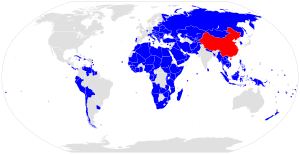Exim Bank of China
The Export–Import Bank of China (Chexim - China Exim Bank) (simplified Chinese: 中国进出口银行; traditional Chinese: 中國進出口銀行; pinyin: Zhōngguó Jìnchūkǒu Yínháng) is one of three institutional banks in China chartered to implement the state policies in industry, foreign trade, economy, and foreign aid to other developing countries, and provide policy financial support so as to promote the export of Chinese products and services. Established in 1994, the bank is subordinated to the State Council.[1]
| Public | |
| Industry | Banking |
| Founded | 1994 |
| Headquarters | Beijing, China |
Key people |
|
| Products | Financial services |
| Website | www.eximbank.gov.cn |
| The Export–Import Bank of China | |||||||
|---|---|---|---|---|---|---|---|
| Simplified Chinese | 中国进出口银行 | ||||||
| Traditional Chinese | 中國進出口銀行 | ||||||
| |||||||
Mission
The bank is a policy bank and along with other Chinese policy institutions like China Development Bank and Sinosure implement the economic policies of the government. The focus of the bank is to promote foreign trade and investment. Commercial lending forms the backbone of the bank. Commercial activity includes export credits mainly in the infrastructure fields (roads, power plants, oil and gas pipelines, telecom, and water projects) and investment loans for Chinese businesses to establish overseas in the energy, mining and industrial sectors.[2] Another function is to administer concessional loans which are no interest or very low interest loans provided as foreign aid by the Chinese government. Exim is the sole provider of Chinese government concessional loans.[2]
Exim does not publish figures for overseas loans. However, U.S. officials estimate that it finances more than the total export financing of the Group of Seven industrialized nations combined.[3] The Financial Times estimates that in 2009 and 2010, China Eximbank and China Development Bank (CDB) together signed loans of at least $110 billion to other developing country governments and companies, more than the World Bank over a similar period.[4]
Rival export financing institutions that have seen a decline in influence, such as the U.S. Export–Import Bank through Chairman Fred Hochberg, have complained that Exim of China doesn't follow the export financing guidelines promulgated by the OECD and so has an unfair advantage.[3]
Foreign aid
The bank is a part of the Chinese foreign aid system and administers the Two Preferential Loan Program (两优贷款业务). The concessional loan (优惠贷款) and preferential export buyer's credit (优惠买方信贷) are the two main loan products under the preferential loan program.[5]
For concessional loans the bank advances a no interest or very low interest rate loan to a developing country government or agency to build a project (e.g. power plant, road, water treatment facility). The term of the concession loan is up to 20 years and a maximum grace period of 7 years is given. The preferential export buyer's credit is provided to a foreign borrower to purchase Chinese goods or services (e.g. construction contractor building the project). Like the concessional loan, this type of loan is also subsidized by the Chinese government. Interest rates are below market rates at around 3 to 6%. However, the preferential export buyer's credit is generally classified as a commercial loan rather than foreign aid even if the interest rate is very low because the purpose is to promote Chinese exports.[6] These two types of loans are a major part of the financing support for China's Belt and Road Initiative.[7]
Organizational structure
Internal Departments
- Executive Office
- Human Resources Department
- Business Development & Innovation Department
- Corporate Business Department
- Shipping Financing Department
- Onlending Department
- Planning & Financial Management Department
- Evaluation Department
- Auditing Department
- Legal Affairs Department
- International Business Department
- Risk Management Department
- Administrative Department
- Supervision Office
- Economic Research Department
- Department of Special Account Financing
- Corporate Business Department
- Concessional Loan Department
- Treasury Department
- Information Technology Department
- Compliance Department
- Accounting Department
- Workers Union
- Software Development Department
- Party & League Affairs Department
Business branches
There are a total of 21 branches of the bank.[8]
- Anhui Branch
- Beijing Branch
- Chengdu Branch
- Chongqing Branch
- Dalian Branch
- Fujian Branch
- Guangdong Branch
- Heilongjiang Branch
- Hubei Branch
- Hunan Branch
- Jiangsu Branch
- Nanjing Branch
- Ningbo Branch
- Qingdao Branch
- Shanghai Branch
- Shanxi Branch
- Shenzhen Branch
- Tianjin Branch
- Xiamen Branch
- Xi'an Branch
- Xinjiang Branch
- Yunnan Branch
- Zhejiang Branch
References
- "Brief Introduction - The Export-Import Bank of China".
- Wang, Jian-Ye (October 2007). What Drives China's Growing Role in Africa? (PDF). IMF Working Paper.
- Reddy, Sudeep. "U.S. Export Financing Challenges China". Retrieved 11 January 2017.
- "Subscribe to read". Retrieved 11 January 2017.
- Handbook on China and Developing Countries. 2015. p. 207.
- "Export Finance Activities by the Chinese Government" (PDF). European Parliament.
- Normative Readings of the Belt and Road Initiative: Road to New Paradigms. Springer International Publishing. 2018. p. 119. ISBN 978-3-319-78017-7.
- "Business Branches". The Export Import Bank of China.
External links
- Official website of China Exim Bank (in English)
.svg.png)
